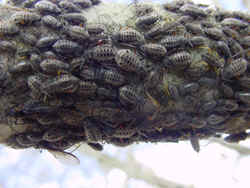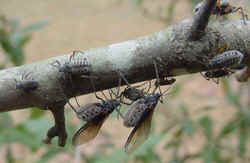An unusual outbreak of giant bark aphids (Longistigma caryae) developed from Houston to Tyler, and points north during the winter of 2002. Since then giant bark aphids have been present in eastern Texas, but in low numbers. These insects come in various forms – some are winged and some are not, some are large and some are small. Giant bark aphids are found in most states in the eastern half of the nation, and interestingly, they are the largest aphids that occur in the United States. Although giant bark aphids are present in low numbers throughout the year in Texas, they occasionally reach outbreak levels, usually during January and February. Outbreaks may persist for four to ten weeks.
Aphids (also called plant lice) feed by sucking sap from their host plant. Giant bark aphids usually feed on twigs where the bark is relatively thin. However, large concentrations of these aphids may be seen on the trunk of a tree where they can form a mass a foot or more across. Water oaks seem to be the preferred host, but other oaks can be infested. These aphids are reported to feed on a variety of additional hardwoods including elm, pecan, sycamore, maple, walnut, and willow. On mature trees, their feeding has minimal impact, but on small trees (less than ten feet tall), they may cause stress and dieback.
Chemical control is not recommended unless a small, high-value tree is heavily infested. Natural enemies play a very important role in controlling aphid populations. Lady beetles, lacewings, certain parasitic wasps, birds, and fungal diseases all attack aphids. Without them, these pests would be much more abundant. However, in January and February, when temperatures are cold, predator and parasite insects are not very active, and this may be the reason aphid populations become so large from time to time. An easy, safe and effective way to remove the aphids from a plant is to wash them off with a strong stream of water. If direct control with an insecticide is warranted, malathion, orthene (acephate), or insecticidal soap should provide good results. If an insecticide is used, read and follow all label directions for specific information on host plants, phytotoxicity information, safety precautions, and dosage information.
As aphids feed, they excrete a sticky, clear liquid known as honeydew. This material will drop onto anything underneath the plant where they are feeding. Honeydew that drops from heavily-infested trees can be a nuisance when it forms a sticky coating on automobiles, picnic tables, lawn furniture, and plants. Additionally, it is attractive to ants, flies, hornets, and yellowjackets. It can easily be washed from the surface of these items with water. However, if not washed, a gray-black, sooty mold soon begins to grow on the sugar-rich honeydew. Sooty mold causes concern because of its unsightly appearance. Also, a thick coating of sooty mold on plant leaves can block sunlight and disrupt photosynthesis. Once the mold begins to grow, it can be difficult to remove and can damage the finish on cars, chairs, tables or other objects.
During outbreaks of giant bark aphids, one should avoid parking vehicles beneath infested trees and move or cover lawn furniture and other items where honeydew is falling. On the other hand, consider it a privilege to see the largest aphid in the United States!
Giant bark aphids are large and easy to recognize. Notice the liquid honeydew present on leaves in one of the photos.

.jpg)

.jpg)